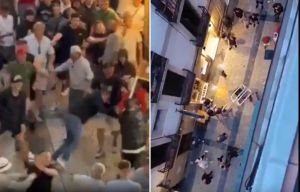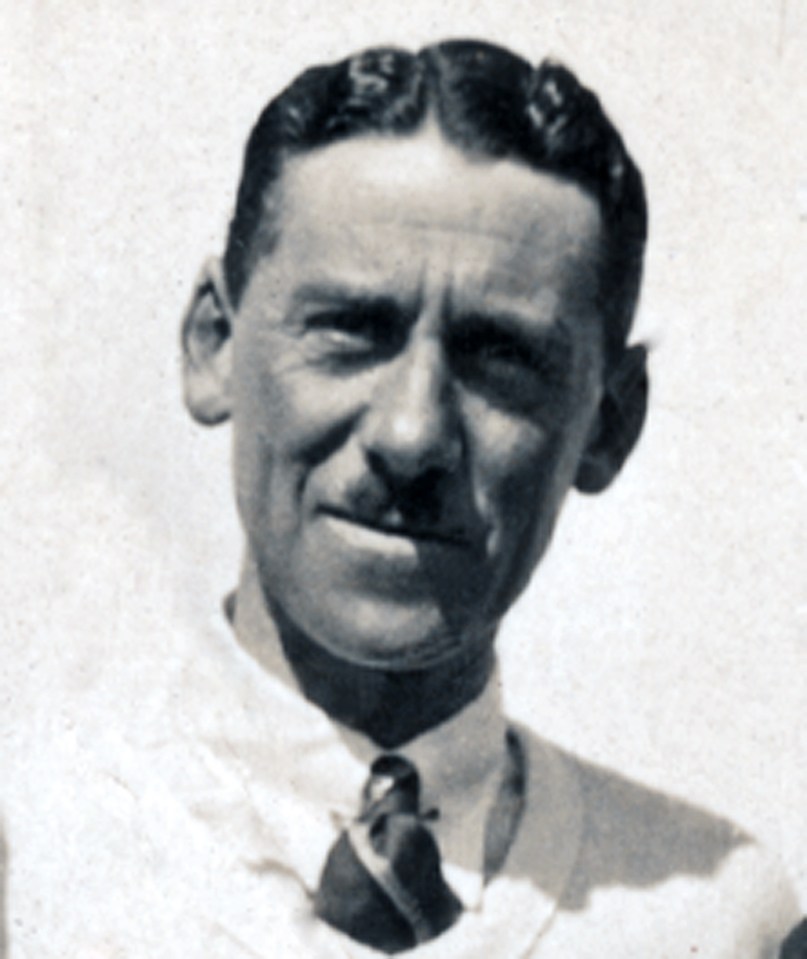Inside shocking cover up of MI6 spy who executed wife but was saved from hangman’s noose and released early

MAJOR William Mackinnon Gray sat shivering in a cell at Winchester jail, awaiting the hangman’s noose.
His wife lay dead on a mortuary slab, killed by a bullet to the temple from his .38 service revolver.
What the public — appalled at the crime committed during the height of World War Two — never knew was that Gray was actually a disgraced ex-MI6 officer, whose misdeeds had already been covered up at least once before.
And while the hangman was assigned a date to bring an end to the disgraced soldier’s life, his execution never took place.
Gray's sentence was quickly commuted to life in prison and then, in secret, just seven years later, he was freed to live in exile.
Until now even Gray’s face has been shielded from public view, his mug shot locked up in the National Archives for seven decades.
Although his secret files were not due to be revealed until 2049, The Sun has succeeded in having them released under Freedom of Information laws and can now tell the full story of Gray’s crimes — and MI6’s part in hushing them up.
The date of the murder was April 10, 1941.
Within the space of 48 hours, Germany would capture the Croatian capital Zagreb then Hungary would join the wider invasion of Yugoslavia.
It marked the start of another bloody chapter of the war, leaving hundreds of thousands dead.
Most read in The Sun
Shots rang out
But it all seemed a million miles away from that spring morning in the Somerset village of Chilcompton, where half a dozen Army officers gathered to bid farewell to their friend Gray, who was moving on to pastures new.
Drinks flowed, photos were taken in the garden and soon lunch was laid out in the officers’ mess, the dining room of a country cottage, Shell House.
But as the men sat down to eat, two shots rang out from a room across the hallway.
They rushed into the room to find Gray and his wife Ryll, both apparently lifeless and covered in blood, she reclining on a sofa and he sat stock-still in an armchair, both with gunshot injuries to the head.
Ryll soon died, while Gray regained consciousness and made a stream of confessions, blood still trickling from his forehead.
“I have blotted my copybook today,” he muttered. “I have shot Ryll and then myself, I’m broke . . . I’m broke financially, utterly and completely broke.”
The extent of Gray’s wounds have never been made clear, but they were not serious.
A bullet was later found below the floorboards of an upstairs room, judged to have entered at a 45-degree angle.
This, it would appear, was the bullet Gray fired at himself.
When in hospital, Gray was cautioned and made a voluntary statement.
He said: “I’ve shot my wife with a .38 revolver . . . How is my wife? Has she stopped breathing? Let me have my revolver, I want to show you two chambers have been fired.”
When asked who fired them, he replied: “I did.” When asked why, he said: “Financial embarrassment.”
Gray was later charged with murdering his wife and attempting to take his own life.
The murder sent shockwaves through the Secret Intelligence Service, otherwise known as MI6.
It was time for a cover- up operation to spare its blushes.
Gray had met Ryll, his second wife, while MI6’s station chief in Sofia, Bulgaria, where he posed as a passport control officer but was charged with keeping tabs on Communist subversives.
Little is know of Gray’s activities in Sofia, but in his book, MI6: The History Of The Secret Intelligence Service 1909-1949, historian Keith Jeffrey noted he had succeeded Engineer Captain Charles Limpenny, an old friend of Sir Hugh Sinclair, otherwise known as C, the chief of the service.
Limpenny was recalled to London to take over as head of the Economic Section, having made a success of his posting.
The same could not be said of Gray.
“Gray had a problematic personal life,” Jeffery wrote.
“In 1936 his (first) wife sued for divorce, and there was concern that his SIS appointment might get mentioned in the proceedings.”
However, the divorce was the least of Gray’s problems.
During the early part of 1937 concerns were raised about “financial irregularities in the payment of an agent”.
C ordered an inspection of the Sofia office and Gray was relieved of his duties.
Gray married Hungarian national Helen Amaryll Gray, known as Ryll, in Sofia the same year.
The relationship was later described in court as a “love match” and they were said to be happy.
The couple bought a farm in Hungary.
They lived there until the Munich Agreement of 1938, which handed Hitler the Sudetenland, then the northern, southern, and western areas of former Czechoslovakia.
After this, all British people were ordered home.
Gray sold up and headed home, where he was eventually allowed to re-join the Army — but not before embarking on an unsuccessful door-to-door sales career that landed him in debt, from which he never escaped.
The night before the shooting, the couple had stayed up into the early hours discussing their money problems.
They owed at least £300 — around £16,000 in today’s money.
On the day of the murder, Gray was handing over control of a company of the 2nd Battalion, East Yorkshire Regiment, to Captain David Dobie, a Dunkirk veteran.
Gray had been forced to move to a different unit due to poor health.
Dobie later found Gray had been stealing company funds to keep himself and Ryll afloat.
Sentenced to death
As the prosecutor at his trial later put it: “Major Gray made it quite clear that his financial position was quite deplorable.”
But little else of note came out at trial — one of MI6’s most senior officers saw to that.
After hearing Gray had murdered his wife, consternation pulsed through the upper echelons of MI6.
Its vice-chief and head of counter-espionage, Valentine Vivian, was sent to Somerset for a “damage limitation” exercise, according to Jeffery’s book
Fearing Gray’s secret service work might be exposed, he convinced Somerset’s chief constable to excise any reference to “passport control” and Gray’s previous career from legal proceedings.
Until today, no photo of Gray has ever emerged, suggesting Vivian might have persuaded Dobie to destroy negatives of photos taken in the garden before the murder.
It would probably have suited MI6 if Gray had succeeded in taking his own life, or at least been declared unfit to stand trial.
But a doctor who examined him before the trial found him to be an “intelligent man” with no evident “mental disorder”.
Prior to the shooting, Gray had experienced no memory problems.
But he claimed to have “amnesia of his acts”.
At trial, Gray pleaded insanity.
On July 15, 1941, a jury took 20 minutes to find him guilty.
Within the hour, at just 39 years old, Gray was sentenced to death.
He was still in the condemned man’s cell at Winchester Prison while the Home Secretary made his decision to commute the sentence — which came just seven days before he was due to die.
This was ratified by a court order on August 12, 1941, when the Honourable Sir Ernest Knight, of the King’s Bench Division, ruled Gray must be “kept in penal servitude for the term of his natural life”.
But that is not what happened.
Gray’s Home Office and Prison Commission files were due to remain sealed until 2049.
But, after a four-month wait, they were released after The Sun made a Freedom of Information request, pointing out that publication could do little harm as almost everyone involved in the story was dead.
In addition to two sets of prison custody photos, the first known snaps of Gray to emerge publicly, the files contained a further revelation — he was secretly released on July 8, 1948, after just seven years, to live his life in exile.
In February 1946, a doctor remarked that Gray had begun referring to the incident as a “suicide pact” but he was “extremely doubtful” that this was the case. The doctor also believed “there is no true amnesia in this case”.
Then, in April 1946, the governor of Isle of Wight prison wrote to the Home Office to say that Gray had once again changed his story.
Gray now accepted that he killed his wife because he could see no way out of the financial mess.
“He could not, he says, leave his wife alive as she would be penniless. So he shot her then attempted to take his own life,” the governor wrote.
Regardless, the final decision appears to have been made on January 19, 1948, when the Home Office wrote to the governor of Leyhill prison, in Gloucestershire, stating it had decided to release Gray on licence after seven years.
No detailed reason was given.
Read More on The Sun
After his release, Gray moved to Beaulieu, Hampshire, before settling in a cottage on Jersey, where he lived with his sister before marrying for a final time.
Gray died on June 19, 1975, at the General Hospital in St Helier, leaving everything to his third wife, Patricia Frances Gray, or, in the event of her death, their son, Richard Duncan Alistair Gray.
















